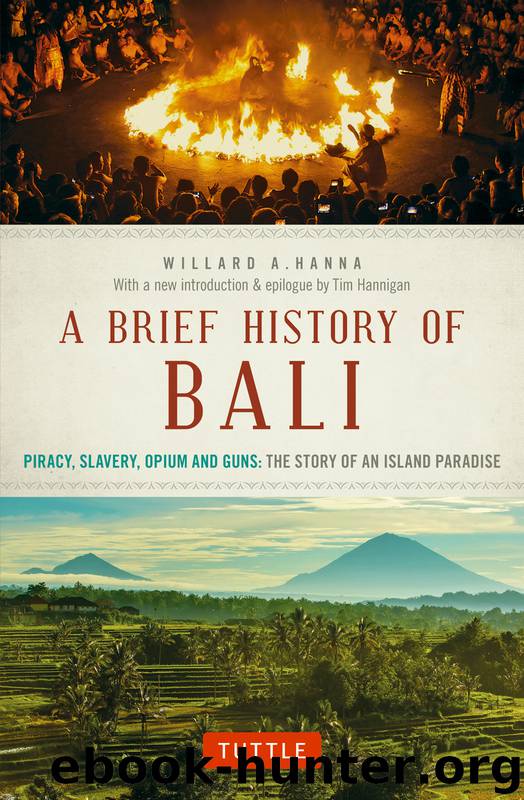A Brief History of Bali by Willard A. Hanna

Author:Willard A. Hanna
Language: eng
Format: epub
ISBN: 978-0-8048-4731-5
Publisher: Tuttle Publishing
Controleur Schwarz and Modern Progress; Sri Kumala Incident (1904)
Thus, in 1900 the Dutch presence began to make itself clearly felt in south Bali just as it had almost half a century earlier in the north. With Controleur Schwarz at hand to guide the Raja, Gianyar went through much the same transformation as that which had occurred decades earlier in Buleleng under the influence of Controleur Bloemen Waanders. The administrative system was regularized; taxes were more efficiently collected and more wisely used; roads and bridges and irrigation systems were improved; other public works were built; health and educational services were introduced, and the system of justice was reformed. The whole state experienced such unaccustomed security and tranquility that the Dutch hailed it as a model of colonial achievement in pacification and development. The model was not one which pleased its neighbors. As the Dutch tactlessly pointed out, Gianyar in the south, like Buleleng earlier in the north, became a sanctuary for refugees from the tyranny of the other rajadoms, such refugees including runaway slaves and people falsely accused of crimes.
The Dewa Agung, in particular, could not be reconciled to the presence of a Dutch Controleur within only a few miles of the sacred Puri Klungkung. He determined to assert his customary authority and he strongly advised Bangli, Badung and Tabanan to do likewise. In his defiance of the Dutch he elected Gianyar as the surrogate object of his attentions. He therefore tolerated if he did not actually instigate the practice of certain of the farmers in the Klungkung–Gianyar border area, who took to planting sharpened bamboo splints in their fields in order to impede the work of the surveyors attempting to determine exact state and property lines. He provided shelter for fugitive criminals and tolerated trade in stolen or smuggled merchandise and committed other minor nuisances far too numerous even for the meticulous Dutch to catalog. The Dutch attempted to deal with the Dewa Agung by sending officials to lodge formal protest and by deploying warships in maneuvers offshore as they did so, but he persisted in his intransigence. It was widely assumed, therefore, that there would soon occur some especially outrageous incident which would launch another Dutch expeditionary force.
The incident happened on May 27, 1904. The Sri Kumala, a Chinese-owned schooner out of Banjarmasin, Borneo, struck the reef near Sanur close to the Badung–Gianyar border, and was allegedly plundered by the people with the approval of the rajas. The Chinese owner of the craft gave an altogether implausible account of his misfortune and demanded an altogether fanciful indemnity for the cargo, to the original itemization of which he added as a curious afterthought large quantities of silver and gold. The Dutch scaled down his claims to a mere fl. 7,500 ($2,500) and presented the bill to the Raja of Badung, who flatly refused to pay. The Dewa Agung backed him in his defiance and so too did the Raja of Tabanan, who happened also to be involved just then in a crisis over a recent ceremony of suttee which he had permitted despite Dutch protest.
Download
This site does not store any files on its server. We only index and link to content provided by other sites. Please contact the content providers to delete copyright contents if any and email us, we'll remove relevant links or contents immediately.
The Secret History by Donna Tartt(16765)
The Social Justice Warrior Handbook by Lisa De Pasquale(11517)
Thirteen Reasons Why by Jay Asher(7857)
This Is How You Lose Her by Junot Diaz(5846)
Weapons of Math Destruction by Cathy O'Neil(5097)
Zero to One by Peter Thiel(4890)
The Myth of the Strong Leader by Archie Brown(4823)
Promise Me, Dad by Joe Biden(4495)
Beartown by Fredrik Backman(4491)
How Democracies Die by Steven Levitsky & Daniel Ziblatt(4469)
Stone's Rules by Roger Stone(4458)
The Fire Next Time by James Baldwin(4401)
100 Deadly Skills by Clint Emerson(4130)
A Higher Loyalty: Truth, Lies, and Leadership by James Comey(4077)
Rise and Kill First by Ronen Bergman(4066)
The David Icke Guide to the Global Conspiracy (and how to end it) by David Icke(3935)
The Farm by Tom Rob Smith(3912)
Secrecy World by Jake Bernstein(3829)
The Doomsday Machine by Daniel Ellsberg(3775)
